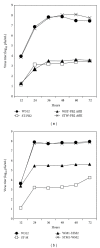Effect of the PB2 and M Genes on the Replication of H6 Influenza Virus in Chickens
- PMID: 24696782
- PMCID: PMC3948651
- DOI: 10.1155/2014/547839
Effect of the PB2 and M Genes on the Replication of H6 Influenza Virus in Chickens
Abstract
H6 subtype influenza viruses are commonly isolated from wild aquatic birds. However, limited information is available regarding H6 influenza virus isolated from chickens. We compared the viral genome segment between A/chicken/Hong Kong/W312/97 (H6N1), which was able to grow in chicken trachea, and A/duck/Shantou/5540/01 (H6N2), which was isolated from wild aquatic duck, to explore the factors for effective replication in chicken. When chickens were inoculated with 7 + 1 reassortants (W312 background), the replication of viruses with PB2 and M genes derived from the duck strain was significantly reduced. Chimeras of PB2 and M proteins, encoding the C-terminal region of the PB2 protein and the M2 protein from W312, were required for efficient replication in canine-derived (MDCK) cells and in chicken trachea. These results indicate that host range may be determined by some types of internal proteins such as PB2 and M2, as well as by surface glycoprotein like hemagglutinin.
Figures



References
-
- Wright PF, Meumann G, Kawaoka Y. Orthomyxoviruses. In: Knipe DM, Howley PM, editors. Fields Virology. 5th edition. Philadelphia, Pa, USA: Wolters Kluwer Health/Lippincott Williams and Wilkins; 2007. pp. 1647–1690.
LinkOut - more resources
Full Text Sources
Other Literature Sources

